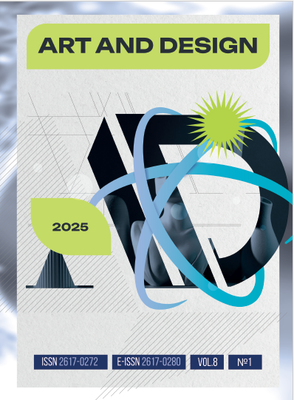Stylistic features of Western ceramics in the first quarter of the 21 st century
DOI:
https://doi.org/10.30857/2617-0272.2025.1.3Keywords:
Michael R.-Fischer, Anselm Reyle, Annette Messager, Graziano Locatelli, Chris Antemann, porcelain, ceramic worksAbstract
This study aimed to present and offer a comparative analysis of ceramic artworks – primarily porcelain – produced by Western artists in the first quarter of the 21 st century, with a focus on identifying common stylistic features. The research methodology incorporated classification, art-historical analysis (including figurative-stylistic and formal approaches), and comparative analysis. The inductive method was applied to examine specific elements
and details of the selected ceramic works. A historical and cultural perspective made it possible to trace changes in both the formal qualities of the pieces and the evolving consciousness of the artists and porcelain manufacturers who produced them. The article features artistic works created by prominent ceramic artists from Western Europe and North America during the specified period. The analysis of pieces by G. Locatelli, A. Reyley, M.R. Fischer, and
V. Hegarty, among others – mainly crafted in porcelain – revealed recurring and comparable stylistic traits among artists working on different continents. A notable inclination towards the deconstruction of surface and form emerged as a defining characteristic of this period, echoing developments in early 20 th -century painting. Destruction and fragmentation have stood out as dominant themes in the early 21 st century. The artist served as a chronicler of
history, inscribing it into material form. The tendency towards destruction was not only affirmed but also preserved by the oldest porcelain manufacturers in Europe: the Meissen Porcelain Manufactory, Augarten in Vienna, and the Royal Porcelain Manufactory in Berlin. Founded during the period when porcelain was regarded as “white gold”, these institutions provide their facilities and technological resources to showcase the spirit of a new age. This shift
reflects not only an awareness of contemporary trends but an acceptance of the realities they express – destruction and anti-form. For the first time, a comparative analysis has been conducted, identifying shared stylistic features in the ceramic works of Western artists from the first quarter of the 21 st century, some of which have been presented by Europe’s most renowned porcelain manufactories. The practical value of this study lies in its potential to contribute to the theoretical shaping of a new, major artistic style. The comparative approach and resulting conclusions may be of use to research institutions in the development of scholarly and methodological resources, academic curricula, and lecture courses on the history of stylistic developments and contemporary decorative and applied arts.

